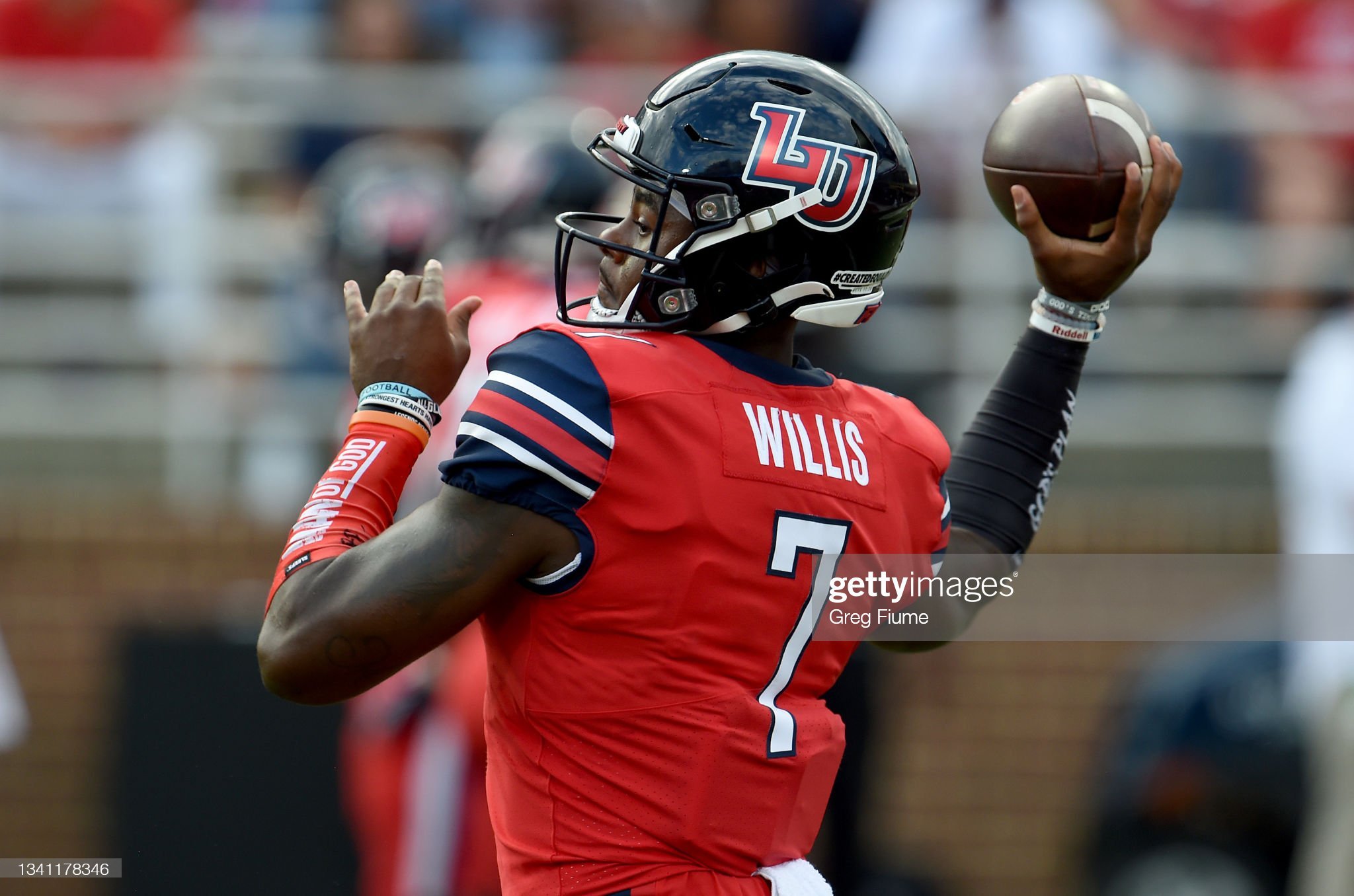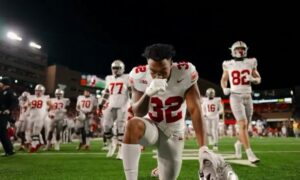To anyone who has been paying attention to the pre-draft process or has been following along the draft coverage here at Steelers Depot, it should come as no surprise that Liberty QB Malik Willis looks to be far-and-away the favorite QB prospect and particularly the apple of HC Mike Tomlin’s eye. The Steelers sent the house to Willis’s Pro Day on March 22 to watch Willis throw in-person, wowing many in attendance with the arm strength, velocity, and touch he exhibited as a passer. However, the trait that Willis also exhibited that Tomlin has made known that he is searching for in his next franchise QB this offseason is mobility, specifically the ability to work outside of structure to extend plays and create with your legs when nothing appears to be there.
Having completed the pre-draft profile on Willis, I too recognize the immense talent that he has as a passer as well as a runner. However, the glaring inconsistencies and bad habits littered throughout his tape initially scared me in terms of how raw he actually is a QB prospect, acknowledging that he will need some fine grooming by an experienced coaching staff in order to have those talents come to fruition at the next level.
Still, I went back through Willis’s game tape and watched more full games from the 2020 and 2021 season, and had a quick thought pop into my head: “How does Malik Willis compare to several other raw, small-school QB prospects that have come out in recent memory?” I decided to comb through the tape and found a few notable names that made sense for this film study as QB prospects from non-Power 5 schools that carried immense upside, but also had their own risks as well as unfinished products. Listed below are the QBs included in this study, relevant measurables, and stats from their final season as well as their full college career courtesy of Sport Reference CFB.
Malik Willis, QB, Liberty
Measurables: 6’0 1/2”, 219lb, 9 1/2” hand, 31 3/4” arm
Career College Stats (35 games played/23 started): 388 completions on 618 attempts (62.8%) for 5,176 yards (8.4 YPA) with 48 TDs and 18 INTs, 152.9 Passing Efficiency Rating, 366 carries for 2,131 yards (5.8YPC) with 29 TDs
Final Season Stats (13 games): 207 completions on 339 attempts (61.1%) for 2,857 yards (8.4 YPA) with 27 TDs and 12 INTs, 151.1 Passing Efficiency Rating, 197 carries for 878 yards (4.5YPC) with 13 TDs
Trey Lance, QB, NDSU
Measurables: 6’3 7/8”, 224lb, 9 1/8” hand, 31 1/2” arm
College Career Stats (19 games played/17 started): 208 completions on 318 attempts (65.4%) for 2,947 yards (9.3YPA) with 30 TDs and one INT, 173.8 Passing Efficiency Rating, 192 carries for 1,325 yards (6.9 YPC) with 18 TDs
Final Full Season Stats (16 games): 192 completions on 287 attempts (66.9%) for 2,786 yards (9.7YPA) with 28 TDs and zero INTs, 180.6 Passing Efficiency Rating, 169 carries for 1,100 yards (6.5YPC) with 14 TDs
Josh Allen, QB Wyoming
Measurables: 6’4 7/8”, 237lb, 10 1/8” hand, 33 1/4” arm
College Career Stats (27 games played/26 starts): 365 completions on 649 attempts (56.2%) for 5,066 yards (7.8YPA) with 44 TDs and 21 INTs, 137.7 Passing Efficiency Rating, 237 carries for 767 yards (3.2YPC) and 12 TDs
Final Season Stats (11 games): 152 completions on 270 attempts (56.2%) for 1,812 yards (6.7YPA) with 16TDs and six INTs, 138.1 Passing Efficiency Rating, 92 carries for 204 yards (2.2YPC) and five TDs
Steve McNair, QB Alcorn State
Measurables: 6’2, 230lb
College Career Stats (43 games played): 980 completions on 1,755 attempts (55.8%) for 15,010 yards (8.5YPA) with 122 TDs, 92.78 Passer Efficiency Rating, 384 carries for 2,295 yards (6.0YPC)
Final Season Stats (11 Games): 356 completions on 612 attempts (58.8%) for 5,377 yards (8.8YPA) with 47 TDs, 102.5 Passer Efficiency Rating, 128 attempts for 904 yards (7.1YPC)
Statistical Takeaways:
After looking at the names listed above, there are some key points to come away with from a pure statistical standpoint. While Willis comes in notably shorter than the likes of Josh Allen and Trey Lance, the arm length and hand size are nearly the same between Willis and Lance. Willis definitely boasts a more similar frame to Steve McNair as a shorter, yet stocky QB. Of the names listed, obviously McNair’s stats are the most impressive given his four seasons in college football playing against Division I AA competition at Alcorn State.
When it comes to stats as a passer, Willis and Allen are extremely similar in terms of games started, number of pass attempts and completions, and passing TDs/INTs thrown. Willis’s rushing statistics more closely mirror that of Lance, and his YPA were greater than that of Allen, but still behind Lance.
One major takeaway I found in this statistical comparison was the completion percentage of the QBs in this study. Willis has often been accused of having erratic accuracy as a passer, lacking the mechanics and sense of timing to consistently put the ball on the mark. However, his overall accuracy percentages aren’t too far off Lance, who also dealt with notable mechanical issues as a passer as referenced by Steelers Depot’s very own Wesley Cantliffe in his pre-draft profile on Lance from last season.
What is more shocking than the comparison between Willis and Lance in terms of accuracy is the comparison of Willis to both Allen and McNair. People often forget that Josh Allen was historically inaccurate coming out of Wyoming, particularly in his final season where his TDs dipped and his INTs rose, failing to surpass 2,000 yards passing. Many draft evaluators, including our team here at Steelers Depot, recognized Allen’s mechanical issues as a passer, lacking ball placement and subtle touch at times while throwing the ball into contested situations with a reckless abandonment that followed him into the league, failing to surpass a 60% completion percentage in his first two seasons as a starting NFL QB.
The Film
Let’s dive into the tape and examine some of the traits of Malik Willis in comparison to the names listed above.
Mobility as a Runner
One of the big draws of Malik Willis as a prospect in comparison to other draft-eligible QBs in this draft class pertains to his athleticism and his ability create with his legs on the ground. Willis boasts a well-built frame and can run with power behind his pads, but he is elusive in the pocket and can sidestep pressure with ease. He can defenders miss with impressive footwork and lateral change of direction skills as he finds space to accelerate forward as you can see on this long run as he evades the rush.
Trey Lance was also lauded for the same skill set coming out of NDSU last season, going for 1,110 yards on the ground in his lone season as a starter on both designed QB runs as well as when he had to create outside of structure with his legs. Like Willis, Lance is a great athlete that has good speed in the open field but also the size and strength to put his shoulder down and run with power.
People often forget how much Wyoming utilized Josh Allen as a runner in their offensive system. While he was used on plenty of designed QB runs and read option plays, he also is more than a capable runner when the play breaks down, creating for himself with his legs as he has accumulated 2,325 yards and 31 TDs on the ground since he has entered the league according to Pro Football Reference.
While the tape of Steve McNair coming out of Alcorn State back in 1994 may not be of the same quality as the more recent examples, it still is pretty easy to see the eerie similarities between he and Malik Willis as runners of the football. They share similar frames and athletic profiles and can create for themselves when the play breaks down and the have to tuck and run. Watch McNair evade the rush here and take off as a runner, scooting to the end zone for six. It may not be a one-for-one comparison, but you can see shades of Willis’ running style when you watch McNair’s game.
Mobility as a Passer
While it is important to be able to create with your legs as a runner of the football and be able to pick up first downs as a dual-threat QB, mobility far exceeds just tucking and running the rock. As a passer, you want to be able to use your mobility to move the pocket, extend plays, and even be able to make off-platform throws that showcase both your arm talent and ability to move as an athlete. Willis is often brought up as the best dual-threat QB in this draft class, but after watching the tape and seeing him throw in-person at the Senior Bowl and NFL Combine, I acknowledge him having the best arm talent in this draft class when it comes to velocity and powering the football from a variety of platforms while on the move.
If you want to see Willis’s arm strength and athleticism encapsulated in one play, this throw against Virginia Tech is the one for you. He takes the snap and immediately rolls out to the right, spinning out of a wimpy tackle attempt in the backfield and then unloads the ball while on the run to the sideline, uncorking it 45 yards with his feet not set underneath him to his receiver who catches the ball along the sideline inside the five-yard line to set up first-and-goal.
Josh Allen’s arm strength and ability to throw the football while on the run are well-documented given his successes thus far in the NFL. He showed those same flashes back at Wyoming as well prior to the 2018 NFL Draft, having the mobility to escape the pocket and power off-platform throws down the field while on the run, placing the ball exactly where it needed to go. Watch this play Allen makes while on the move against Nebraska and how it is nearly identical to the same throw Willis makes above as he rolls out to his right and delivers a strike in the end zone for the score.
Trey Lance received a lot of praise from scouts for having a similar skill set in terms of being able to extend plays as a passer and make throws even when his feet were not set when he threw. Here is a throw against Montana State where Lance looks to his first read in the flat on the left side, then turns back to the right after being forced from the pocket, rolling to his right and delivers a strike while on the move to his receiver along the right sideline in a similar fashion that Allen and Willis did in the previous examples.
Even while it was more common back in the mid-90s to be a pocket passer than it is today, Steve McNair showed a similar skill set as the other guys above in terms of being able to escape the pocket when the plays started to break down that the pass rush started to close in and be able to make big-time throws down the field while on the move. Watch this play McNair makes while he too works to his right to evade the rush, showing off his arm strength to make a throw over the middle of the field while on the run.
Arm Strength/Velocity
Arm strength is often referred to how far someone can physically throw a football. While can be one aspect of arm strength, velocity or the speed at which the ball travels to its intended destination is another aspect that is vital to success at the QB position. You want to have the ball be able to arrive on-time to its intended target while not allowing a defender the opportunity to jump the route should the ball be slow to make it there. When watching Willis throw, you notice the ball jump off his hand.
The deep out route is often referenced as one of the toughest throws in football since the passer has the throw the football with enough touch and velocity to put the ball on his intended target on-time before the coverage defender hands a chance to play the ball or undercut the route. Willis displays at the Senior Bowl and NFL Combine that he provided the best zip on passes outside the numbers and there are several instances in Willis’ tape that show he can make these throws thanks to his arm like this play against the Rebels.
The other QBs mentioned in this study also have this ability to drive the ball outside the numbers with enough zip and velocity to get the ball there, showcasing that arm strength. Here we see an example of Trey Lance making a similar throw outside the numbers while on the move, rolling to his left and completes the pass while getting hit by a defender to #1 Christian Watson breaking toward the sideline.
Here is a similar throw made by McNair from the pocket, completing his drop back and steps up to throw, driving the football on a rope to the left sideline out of reach of the defender but within reach of his intended receiver who is able to bring in the pass for the completion.
Willis’s ability to throw on the run without his feet set underneath is a testament to his arm strength and his mobility as a QB prospect. Here against the Hokies, we see Willis have all the green grass to take off but still keeps his eyes downfield, seeing his receiver streak across the middle of the field in the end zone where Willis delivers a dart of a pass on a line while running forward to his man for the score.
Josh Allen possesses that same ability to make those off-platform throws like we see on this TD pass, rolling to his right and throws off his back foot, having the arm strength and touch to place the ball over the defender to his receiver in the end zone for the score.
Another important component of arm strength is the ability to make throws while being hit by the defense, yet can still stare down the gun barrel and make the play when knowing you are going to take a shot. Willis has shown on several occasions that he has the arm talent and poise to make such throws in crucial situations. Here is one example where Willis attempts to step up in the pocket to evade the rush coming off the edge, but gets drilled in the side as the releases the football. Still, Willis manages to throw the ball 40 yards on a line to his receiver for the score.
While this clip doesn’t have Allen step up in the pocket, he does make the pass completion while under pressure, taking a big shot by the defensive lineman looping in for the clean hit. Allen manages to generate enough velocity on the pass with his feet set in the ground to his intended target on the out route, moving the chains for the offense.
Reading Defenses/Mechanics
While Willis shares plenty of positive traits when compared to the likes of Allen and Lance, he also shares plenty of the concerns both prospects had when they were going through the pre-draft process. All of these QBs have been touted for having immense physical traits and the upside to become a franchise QB, but they also had mechanical issues as passers as well as the tendency to force passes into coverage due to the trust they have in their respective arms.
Willis would be wise to be more risk-adverse and choose to live to fight another down rather than trying to force the ball where it shouldn’t go. His faith in his arm can fail him at times as a passer, attempting to make passes he never should. Take, for example, this INT thrown against Ole Mis this season where Willis looks at his check down option in the flat, but then takes his eyes to the receiver streaking down the field, not stepping into his throw and throwing the ball short where the safety easily undercuts the pass and picks it off and starts running the other direction.
Luckily for Willis, he isn’t alone when it comes to forcing the football in places where it ought not to go. Josh Allen had a historically low completion percentage coming out of Wyoming and started out his NFL career shaky in terms of his accuracy. His mechanics took a lot of work in terms of throwing with a better base and not allowing his elbow to flare out on him when he threw. Here is an example against BYU where Allen displays too much faith in his arm talent, forcing the ball into tight coverage while throwing off his back leg, having the DB undercut the route for the INT.
While Trey Lance only had one INT on his ledger during his college career, he too struggled with ball placement as a passer at times, struggling to put passes on-target outside the numbers as well as relying on his arm strength to complete passes rather than throwing from a solid base. Here is his lone INT at NDSU were we see him step up and whip the ball over the middle of the field, failing to recognize the safety staring him down from center field who comes down and undercuts the route for the pick.
Concluding Thoughts
After doing a further deep-dive into Malik Willis’ game tape, I have come away higher on him than I was during my initial pre-draft breakdown. He possesses the skill set and traits that you simply cannot teach, both as a passer as well as a threat on the ground. His tape is littered with those “wow” moments that jump off the screen and scream upside as a potential franchise QB in an age where mobility and being able to challenge defenses with your arm as well as your legs is becoming the norm that NFL teams are searching for. Still, after getting to know Willis more at the Senior Bowl and NFL Combine, you find out that this is a guy that is family-oriented, is a team player, and has his head on straight in terms of wanting to get better to be the best football player as well as human being possible.
It would have been easy to try and compare Willis to other similar style QBs that he is often comped to like Lamar Jackson, Jalen Hurts, or Michael Vick. However, for the purpose of this study, I wanted to compare him to other small-school prospects that should have dominated their respective competition and possessed the rare physical tools to be successful NFL QBs, but also carried the risk factor of needing refinement to their game. Steve McNair blew away the competition at Alcorn State, but saw a tougher time establishing himself in the league, taking two seasons to become an 16-game starter in Year 3 while never surpassing a completion percentage of 65% in his 13-year NFL career.
Lance was more productive in his lone season as a starter for the Bison, but also struggled with the finer details of the QB position, essentially taking a redshirt year this past season in San Fransisco where he saw some action with mixed results, suggesting that the skill set is there to thrive, but still needs that seasoning to become a reliable starter.
Walking away from this study, I couldn’t believe the amount of similarities that came up between Willis and Josh Allen as prospects. Both prospects starred at non-Power 5 schools and showcased elite arm strength and athleticism to create plays outside of structure on the ground, but also exhibited concerning moments where they appeared oblivious to opposing coverages and would make egregious mistakes due to lack of mechanics, footwork, or situational awareness. Allen possesses more top-end arm talent, but he struggled more than Willis in terms of ball placement in college which initially followed him to the league, taking two full seasons as a starter to exceed a completion percentage greater than 60% in what would be his breakout third season.
We have seen a shift in mindset when drafting QBs over the last several years. Instead of drafting the “pro-ready” prospect that has a nice floor but limited ceiling, some teams have opted to take the prospect that projects more as a project, possessing those immense physical traits but need time to work out the “kinks” like the Bills did with Josh Allen or the Chiefs did with Patrick Mahomes. After watching that AFC Divisional showdown between those two, it became apparent to many teams searching for QBs that you need to bet on the upside in a prospect in order to have a chance at finding a guy that can do the things those guys can do on a football field at the QB position.
I conclude that Malik Willis possesses those traits to have that kind of ceiling in the NFL. He has the upside similar to that of Trey Lance, Josh Allen, and even Steve McNair as referenced in this study to be an X-factor at the next level, having the mobility and arm talent that you simply cannot teach. However, he will need a development plan to ensure he transitions to the league smoothly, not being forced into actions too soon to stunt said development. The 49ers implemented this plan for Trey Lance last season, and the Bills and Chiefs have done the same for Allen and Mahomes, allowing them to sit and learn initially before being thrust into the fire.
The coaching staff also plays a big role in the QB’s development as Kyle Shanahan, Brian Daboll, and Andy Reid are often regarded as great offensive minds that meld their offenses to a QB’s strengths. It remains to be seen whether or not Pittsburgh can rely on OC Matt Canada and QB Coach Mike Sullivan to properly develop the next franchise QB. However, if that guy is readily available and it is up to your coaching staff to be able to develop that player, you have to take that shot. Malik Willis has been the name most associated with the Pittsburgh Steelers this offseason and for good reason. I am confident today saying that if the team feels like they can put together a proper development plan for a player of his skill set, he should be their #1 target come draft day.
What are your thoughts on Malik Willis as a QB prospect? How do you think he compares to the likes of Trey Lance, Josh Allen, and Steve McNair coming out of college as draft prospects from smaller schools? Do you envision Willis having a similar career arc as these players if developed properly by a coaching staff? Please leave your thoughts in the comments section below and thanks again for reading!








